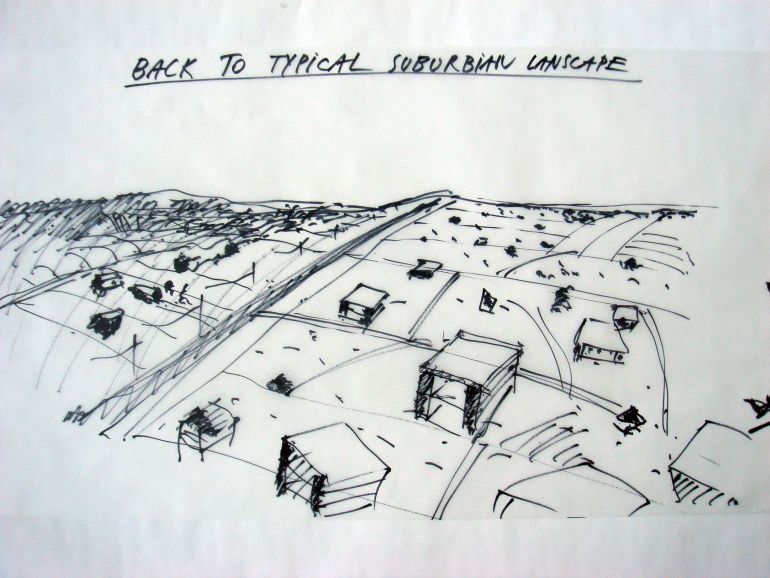
- Is there a model for office?
- I think not, as there is no standard model apartment. Each client has their own policy preferences as well as financial and aesthetic preferences. It's easier to be original, if you are designing a building for the particular end user (so-called "corporate head office"). When you build an office to rent, buildings are generally reasonable and cheap, they implement the market guidelines of the investor, which we often seen in the landscape of our cities. Only the quality of the finishes and appliances, not to mention the essential thing, the quality of architects' imagination, decide which class represents the office.
- You engaged your imagination to create a very original vision of the perfect office for a Polish employee. In this project you take into account not only the operating characteristics of the Polish nation, but above all the typical characteristics of our disordered space. You took the disadvantage for the value?
- The starting point was a hypothetical suburban location: somewhere between town and country, so in the suburbs. In Poland, the most degraded area, chaotic: the narrow land placed in free and disordered system. Every owner builds on them what he wants, how he wants, and how the shape of the land is letting him to do it. This space is not organized in any way or according to some sort of a plan, it is uncontrolled, so-called urban sprawl. Yes, this type of space can at some point be considered as a kind of value - the matrix, even for culturally valuable space - space of Polish identity,with a king of untamed smell of freedom, which should be protected! The arrangement of this space would mean that the space is ruined! Who knows, maybe in a few years we will miss its loss!
Designing of our ideal office starts with one work-place for model Pole-individualist.What is the required space for one person? I define it as 2x2 m. This is similar to the surface dimensions of the two Japanese tatami. Japanese foam mattress are generally 180 x 90 cm, but the Japanese people are shorter, so Polish tatami can have the dimensions of 200x100 cm. This size is important because in the office, sometimes - especially before making strategic decisions - you need to lie down, relax and think about the matter. Today, we work for a very long time. In our office, basic equipment is, of course, a work desk and ergonomic chair.
Referring to the tradition of the Polish residential architecture, in my new "office in the suburbs," I allow the equivalent of the white chamber - where you work and welcome guests - and black chambers that supports it. I created the concept of modules, black and white chambers, with windows in the middle of walls or in corners, which can be combined horizontally and vertically, yielding countless combinations of offices, capable of fitting on any, irregular plot of land in Polish suburbs.
- Why did you decide to locate the office in the suburbs? Contemporary experience of investors indicate that they significantly are more likely to invest in office buildings near the center of the city, for example because of access to public transport.
- Cities, especially historical, such as Krakow, are finite organisms. For a long time now, there is no room for new investments in city centre, so in the last decades we see the process of spreading the cities to the suburbs. Today on this area, we primarily build homes and multi-family buildings, but soon they may become attractive areas for offices. So I placed offices there, in different configurations, not organizing the space, but preserving the chaotic, local character.
- The building built by your project for the company Buma, "Capgemini" on Bora-Komorowskiego street is one of the finest buildings in Krakow, and certainly it organizies the space perfectly. In spite of such experience, you say, that chaos should be preserved?
- Presented comic is just theoretical fun, the actual design of the space should be associated with the creation of clear urban governance. Office building Rondo Business Park by the Bora-Komorowskiego street was built to complete such a task - to be an accent of the entire urban area Olsza II - and a landmark at the roundabout Polsadu.Its shape is designed so that each side elevations are different, they have their own character, so it is easy to determine the orientation just by looking at it.
- Let's look inside a modern office building, where the so-called open space became a hit. Subsequent floors of modern office buildings resemble production halls with hundreds of identical positions. Is this the perfect solution for office space, which one does not discuss today?
- I do not think it is the most perfect solution, and the best proof is our office in an old house with several rooms, with separate teams of designers in each of them. I would not change it for a simple open space. This does not mean that open space does not have its advantages. It has, and those mentioning them on one breath, are those who can take advantage of the intimate workplace. I remember how during my stay in the United States, I had the opportunity to talk to the president of the company conducting the tests of office work, productivity of workers, solutions in the field of ergonomics and economics. Well, the American, extolling the benefits of teamwork and open work space, at one point said that he feels best when your caller can sit in your favorite, cozy restaurant, isolated from the rest, focused on his guest and the music of Bach. Bach - if I'm not mistaken - had no assistants and worked individually. Anyone who works creatively, would be disturbed by the presence of numerous companies around him. So important is the ability to isolate and focus the group, in addition to the possibility of a joint work. But - seriously - for many institutions, particularly for companies with large-scale operation, open space is the perfect solution.
- What circumstances determine that the office like factory floor is the best option?
- Open space offices are ideal for corporations in the U.S. and Japan, in countries where there is a long tradition of teamwork and where they put a lot of emphasis on it. In addition to an open space, there always exist some smaller and more isolated areas where employees may formally or informally meet and talk. The spatial model of an office is justified in corporations that have defined the work and set goals to achieve and must do so, in a way planned in advance and controllable. Only open space allows you to easily and flexibly organize and supervise the work of a very large group of people. One of the desirable characteristics of employees, which is taken into account when recruiting international companies is the ability to adapt to the nature of teamwork. Individualists tire themselves in such conditions. Poles - as a nation - like to work individually, which in the current labor market is an advantage.
- Open space does not fit the character of the Pole?
- For many years it did not fit. Everyone would like to have their own room with a view out of the window and its own kettle for making tea. But this, of course changes, the times of communism are gone, and with them went the old stereotype of an official office, who is closed in the room and is "spending" time on drinking tea. Today, a man from a big office building is identified with a corporate employee, working in different environments and spaces, in constant motion, and isolation from his desk, but tied to the Internet and all the new technologies.Preparing a kind of comic about a hypothetical workplace of a Pole, of course, in the form of a joke, I referred to the Polish individualism, but treating it with a large distance. I tried to sketch the place of his work according to the national value. Of course, it is only to show the consequences of this line of thinking, this is not a project to be implemented. This is rather an anecdote, a joke, a discussion of stereotypes and a tradition of architecture, as well as the Polish traits and preferences.
Thank you for your time
Assistant Professor, Ph.D. KRZYSZTOF INGARDEN - architect,
Assistant Professor at the A. F. Modrzewski Faculty of Architecture and Fine Arts Academy in Krakow.
laureate of the SARP Prize of Honour 2009. Along with Jacek Ewy, he runs the "Ingarden-Ewy Architekci" company;
author of may projects, including: Embassy in Tokyo, the Polish Pavilion at EXPO 2005 Aichi, Japan;
Wyspiański pavilion, 2000 in Krakow, Krakow Congress Centre, the curator of architecture exhibitions:
„3-2-1 Nowa Architektura Polska i Japońska”(2004), „Architekci polscy dla Japonii”(2011).
Since 2002 he has been the Honorary General Consul of Japan in Krakow.


